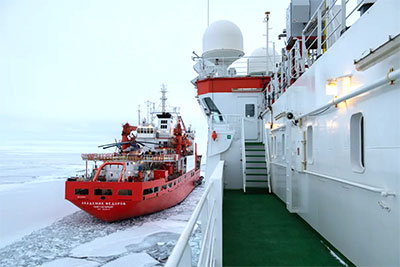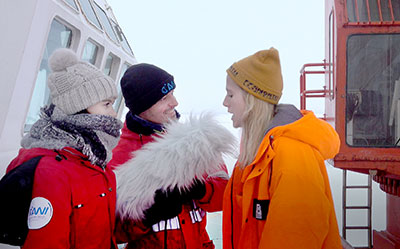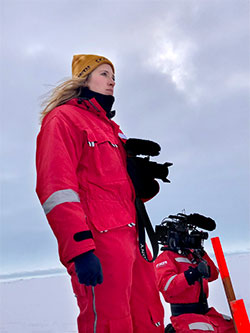
The Multidisciplinary drifting Observatory for the Study of Arctic Climate (MOSAiC) expedition represents the world’s greatest arctic research endeavour and is a milestone in climate research.
One of those taking part in the expedition was Friederike Marie Krüger, a German teacher who exchanged classroom for a research ship berth for six weeks in order to create teaching materials. She also made a documentary using Sennheiser microphones.
The expedition set out from Tromsø in Norway in September 2019 and its main expedition vessel, the icebreaker Polarstern, returned to its home port of Bremerhaven, Germany, in October 2020. During its voyage, the Polarstern had docked onto Arctic sea ice and drifted through the Arctic Ocean on a gigantic ice floe. As the ship drifted with the ice, it had contact with a network of measuring stations covering many kilometres. One aim of the expedition was to gain a better understanding of the Arctic’s influence on the global climate in order to make more reliable predictions.
‘I wrote my dissertation at university on the global melting of glaciers,’ explains Krüger, now geography teacher. ‘While I was a student and in the years afterwards, I travelled to Iceland many times and became fascinated by Nordic regions. But it was entirely by chance that I came across an advertisement for the MOSAiC expedition –looking for teachers to accompany the project. Actually, this is quite common practice in research expeditions, as the aim is to open up additional perspectives to a broader public.’
To record her Arctic impressions, Krüger borrowed a compact camera with a CMOS sensor and a built-in zoom lens. She also took two Sennheiser microphones along with her.
Full floe
 She set off onboard the Russian research vessel Akademik Federov, which accompanied the Polarstern during the first phase of the expedition and carried supplies of marine diesel and additional measuring equipment. Once the Polarstern had docked on a suitable ice floe, a ship-to-ship transfer of people and material took place, after which the two icebreakers remained at a distance to prevent damage to the floe and avoid any negative influence on the measurements.
She set off onboard the Russian research vessel Akademik Federov, which accompanied the Polarstern during the first phase of the expedition and carried supplies of marine diesel and additional measuring equipment. Once the Polarstern had docked on a suitable ice floe, a ship-to-ship transfer of people and material took place, after which the two icebreakers remained at a distance to prevent damage to the floe and avoid any negative influence on the measurements.
Students at Krüger’s school, IGS Bothfeld, were keen to hear about their teacher’s adventure, and she kept in contact with them as best she could. ‘Of course, the students always asked whether I was going to see some polar bears,’ Krüger recalls. ‘But they also asked about more personal things, such as whether I felt homesick and the special problems of living on a ship. They also wanted to know what sense it made, from an environmental perspective, to plough through untouched Arctic nature with several icebreakers with powerful diesel engines.’
Krüger quickly mastered the previously unfamiliar video and audio equipment: ‘The video recordings in 4K and full HD resolution came out really well, and the same is true of the sound,’ she says. ‘At the beginning, I intended to use the compact camera but fortunately, just five days before I left, two Sennheiser microphones arrived.’
Most of Krüger’s recordings were made outside and show the spectacular landscape and the scientists at work. As extremely low temperatures are known to have a negative effect on battery capacity, she had packed additional sets of batteries, which were kept as warm as possible while she was filming outside, and she also took care to hold the compact camera close to her body.
 Outside temperatures ranged between -20°C and -25°C:‘The freezing cold still meant that the camera’s autofocus function stopped working after a short time and I had to go inside the warm cabin for a while before I could continue filming,’ she says.
Outside temperatures ranged between -20°C and -25°C:‘The freezing cold still meant that the camera’s autofocus function stopped working after a short time and I had to go inside the warm cabin for a while before I could continue filming,’ she says.
For sound recording onboard the ship, she mainly used an MKE 440 mounted on the camera’s shoe mount. In this compact stereo microphone, two capsules in a V-shaped configuration cover an area corresponding to the recording angle of a 35mm camera lens, ensuring homogeneous coverage of the entire area with high speech intelligibility in the image focus. She also used an MZH 440 fur windshield for the mic.
For outside recordings, Krüger used a Sennheiser MKH 416, which was protected from wind noise by an MZW 60-1 basket windshield fitted with an MZH 60-1 hairy cover. The short shotgun mic was mounted on an MZS 20-1 suspension with a pistol grip that made it easy to control. ‘I quickly learned how important it is in an interview situation to point the shotgun microphone directly at the interview partner…,’ Krüger adds.
The MKH 416 was connected via an XLR cable to a Sennheiser MZA 14 P48 U battery power supply unit, which also provided it with phantom power. The signal was recorded with automatic level control through the camera’s 3.5mm stereo input. The recordings were stored on SD cards inside the camera until Krüger was able to save them on her laptop and external hard drives when she got back onboard the ship.
Sound on ice
Krüger describes vividly the haunting sound of ice compression as the ice floe is crushed by sea swell, tides and the wind before being pressed with incredible force against the ship’s hull. ‘I would compare it to the sound of a creaking steel door in an empty warehouse – but ten times louder, and right next to your bed!’
 In fact, this natural phenomenon was already described more than 125 years ago by Norwegian explorer Fridtjof Nansen, whose work is still an inspiration for Arctic expeditions today.
In fact, this natural phenomenon was already described more than 125 years ago by Norwegian explorer Fridtjof Nansen, whose work is still an inspiration for Arctic expeditions today.
‘The Sennheiser microphones did a fantastic job in spite of the harsh Arctic conditions and I never had any problems with either of the models,’ Krüger reports with satisfaction. ‘The sound recordings were really successful: the MKE 440 definitely proved itself during the indoor recordings on board, while the MKH 416 showed its strengths as a shotgun microphone during the outside recordings. The basket windshield and protective cover meant that wind noise was never an issue.’
Krüger is glad that she took the microphones with her: ‘At the beginning, I must admit that I never really thought too much about such things as sound quality and I was simply intending to use the camera’s built-in mini microphone,’ she admits. ‘It was only when I got onboard the ship that I realised just how important good microphones are if you want to record interviews with intelligible sound and to record sound in high quality. The Sennheiser equipment was a tremendous help for me on the expedition.’
Since returning home, she has conveyed her fascination for the Arctic to students and staff members at IGS Bothfeld, and given lectures at schools throughout Germany alongside corresponding classroom activities. She is now planning university seminars for geography teachers, as well as preparing projects with museums. Krüger’s video and sound recordings can be found, together with other material, on the MOSAiC web page.












